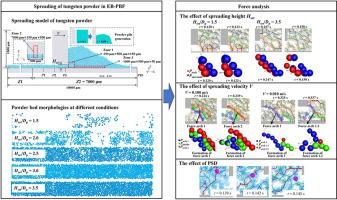Micro-mechanical analysis on the spreading of tungsten powder in electron beam powder bed fusion additive manufacturing
IF 4.3
2区 材料科学
Q2 ENGINEERING, CHEMICAL
引用次数: 0
Abstract
Electron beam powder bed fusion (EB-PBF) enables the additive manufacturing of high-melting-point, reactive metals like tungsten. However, the quality of the powder bed is governed by the micro-mechanics of powder spreading, which remain unclear. In this work, the spreading of tungsten powder during EB-PBF process was numerically reproduced by three-dimensional discrete element method. Micro-mechanics (particle motion behaviors, evolution of contact forces and formation of force arches) of the powder spreading were analyzed under varying operating parameters (spreading velocity (V), spreading height (Hset)) and particle size distribution (PSD). Additionally, powder bed density ρ and surface roughness Ra were also evaluated. Results indicate that low Hset facilitates the formation of short-length, stable force arches in front of the recoater, hindering powder fall onto the substrate. At low V, the force arches undergo partial collapse and are subsequently restored by surrounding particles, enabling high-frequency, small-quantity powder deposition, which results in higher ρ and lower Ra. Conversely, at high V, force arches collapse completely and require longer rebuilding periods, leading to periodic powder deposition and large voids in the powder bed. Increasing PSD standard deviation facilitates the stable force arches by large particles, permitting small particle percolation, which reduces ρ and Ra.

电子束粉末床熔融增材制造中钨粉扩散的微观力学分析
电子束粉末床熔合(EB-PBF)使高熔点活性金属(如钨)的增材制造成为可能。然而,粉末床的质量是由粉末扩散的微观力学决定的,这一点尚不清楚。本文采用三维离散元法对EB-PBF过程中钨粉的扩散过程进行了数值模拟。分析了不同操作参数(扩散速度(V)、扩散高度(Hset)和粒径分布(PSD)下粉末扩散的微观力学(颗粒运动行为、接触力演化和力拱形成)。此外,还评估了粉末床密度ρ和表面粗糙度Ra。结果表明,低Hset有利于在涂层前形成短长度、稳定的力拱,阻碍粉末落到基体上。在低电压下,力弓发生部分坍塌,随后被周围的颗粒恢复,从而实现高频、小数量的粉末沉积,从而导致更高的ρ和更低的Ra。相反,在高V下,力拱完全坍塌,需要更长的重建周期,导致周期性粉末沉积和粉末床中的大空隙。增大PSD标准差有利于大颗粒形成稳定的力拱,允许小颗粒渗流,从而降低ρ和Ra。
本文章由计算机程序翻译,如有差异,请以英文原文为准。
求助全文
约1分钟内获得全文
求助全文
来源期刊

Particuology
工程技术-材料科学:综合
CiteScore
6.70
自引率
2.90%
发文量
1730
审稿时长
32 days
期刊介绍:
The word ‘particuology’ was coined to parallel the discipline for the science and technology of particles.
Particuology is an interdisciplinary journal that publishes frontier research articles and critical reviews on the discovery, formulation and engineering of particulate materials, processes and systems. It especially welcomes contributions utilising advanced theoretical, modelling and measurement methods to enable the discovery and creation of new particulate materials, and the manufacturing of functional particulate-based products, such as sensors.
Papers are handled by Thematic Editors who oversee contributions from specific subject fields. These fields are classified into: Particle Synthesis and Modification; Particle Characterization and Measurement; Granular Systems and Bulk Solids Technology; Fluidization and Particle-Fluid Systems; Aerosols; and Applications of Particle Technology.
Key topics concerning the creation and processing of particulates include:
-Modelling and simulation of particle formation, collective behaviour of particles and systems for particle production over a broad spectrum of length scales
-Mining of experimental data for particle synthesis and surface properties to facilitate the creation of new materials and processes
-Particle design and preparation including controlled response and sensing functionalities in formation, delivery systems and biological systems, etc.
-Experimental and computational methods for visualization and analysis of particulate system.
These topics are broadly relevant to the production of materials, pharmaceuticals and food, and to the conversion of energy resources to fuels and protection of the environment.
 求助内容:
求助内容: 应助结果提醒方式:
应助结果提醒方式:


